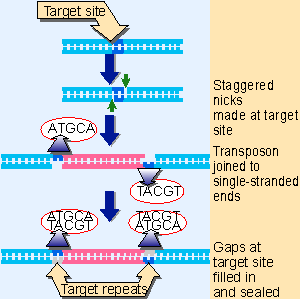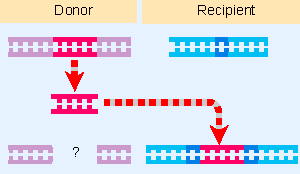4. Transposition occurs by both replicative and nonreplicative mechanisms
15.4 Transposition occurs by both replicative and nonreplicative mechanisms |
| Key terms defined in this section |
| Conservative transposition refers to the movement of large elements, originally classified as transposons, but now considered to be episomes. The mechanism of movement resembles that of phage lambda. Nonreplicative transposition describes the movement of a transposon that leaves a donor site (usually generating a double-strand break) and moves to a new site. Replicative transposition describes the movement of a transposon by a mechanism in which first it is replicated, and then one copy is transferred to a new site. Resolvase is enzyme activity involved in site-specific recombination between two transposons present as direct repeats in a cointegrate structure. Transposase is the enzyme activity involved in insertion of transposon at a new site. |
 |
Figure 15.4 The direct repeats of target DNA flanking a transposon are generated by the introduction of staggered cuts whose protruding ends are linked to the transposon. |
The insertion of a transposon into a new site is illustrated in Figure 15.4. It consists of making staggered breaks in the target DNA, joining the transposon to the protruding single-stranded ends, and filling in the gaps. The generation and filling of the staggered ends explain the occurrence of the direct repeats of target DNA at the site of insertion. The stagger between the cuts on the two strands determines the length of the direct repeats; so the target repeat characteristic of each transposon reflects the geometry of the enzyme involved in cutting target DNA (for review see Grindley and Reed, 1985).
The use of staggered ends is common to all means of transposition, but we can distinguish three different types of mechanism by which a transposon moves:
- In replicative transposition, the element is duplicated during the reaction, so that the transposing entity is a copy of the original element. Figure 15.5 summarizes the results of such a transposition. The transposon is copied as part of its movement. One copy remains at the original site, while the other inserts at the new site. So transposition is accompanied by an increase in the number of copies of the transposon. Replicative transposition involves two types of enzymatic activity: a transposase that acts on the ends of the original transposon; and a resolvase that acts on the duplicated copies. A group of transposons related to TnA move only by replicative transposition (see later).

Figure 15.6 Nonreplicative transposition allows a transposon to move as a physical entity from a donor to a recipient site. This leaves a break at the donor site, which is lethal unless it can be repaired. - In nonreplicative transposition, the transposing element moves as a physical entity directly from one site to another, and is conserved. The insertion sequences and composite transposons Tn10 and Tn5 use the mechanism shown in Figure 15.6, which involves the release of the transposon from the flanking donor DNA during transfer. This type of mechanism requires only a transposase. Both mechanisms of nonreplicative transposition cause the element to be inserted at the target site and lost from the donor site. What happens to the donor molecule after a nonreplicative transposition? Its survival requires that host repair systems recognize the double Vstrand break and repair it. Another mechanism utilizes the connection of donor and target DNA sequences and shares some steps with replicative transposition (see next section).

Figure 15.7 Conservative transposition involves direct movement with no loss of nucleotide bonds; compare with lambda integration and excision. - Conservative transposition describes another sort of nonreplicative event, in which the element is excised from the donor site and inserted into a target site by a series of events in which every nucleotide bond is conserved. Figure 15.7 summarizes the result of a conservative event. This exactly resembles the mechanism of lambda integration discussed in 11 Phage strategies, and the transposases of such elements are related to the λ integrase family. The elements that use this mechanism are large, and can mediate transfer not only of the element itself but also of donor DNA from one bacterium to another. Although originally classified as transposons, such elements may more properly be regarded as episomes (for review see Scott and Churchward, 1995).
 |
Figure 15.5 Replicative transposition creates a copy of the transposon, which inserts at a recipient site. The donor site remains unchanged, so both donor and recipient have a copy of the transposon. |
Although some transposons use only one type of pathway for transposition, others may be able to use multiple pathways. The elements IS1 and IS903 use both nonreplicative and replicative pathways, and the ability of phage Mu to turn to either type of pathway from a common intermediate has been well characterized (see later).
The same basic types of reaction are involved in all classes of transposition event. The ends of the transposon are disconnected from the donor DNA by cleavage reactions that generate 3′ VOH ends. Then the exposed ends are joined to the target DNA by transfer reactions, involving transesterification in which the 3′ VOH end directly attacks the target DNA. These reactions take place within a nucleoprotein complex that contains the necessary enzymes and both ends of the transposon. Transposons differ as to whether the target DNA is recognized before or after the cleavage of the transposon itself.
The choice of target site is in effect made by the transposase. In some cases, the target is chosen virtually at random. In others, there is specificity for a consensus sequence, for a structure, such as bent DNA, or for inactive regions of the chromosome.
| Reviews | |
| Grindley, N. D. and Reed, R. R. (1985). Transpositional recombination in prokaryotes. Ann. Rev. Biochem 54, 863-896. | |
| Scott, J. R. and Churchward, G. G. (1995). Conjugative transposition. Ann. Rev. Immunol. 49, 367-397. | |